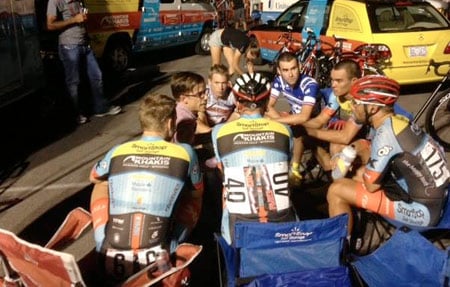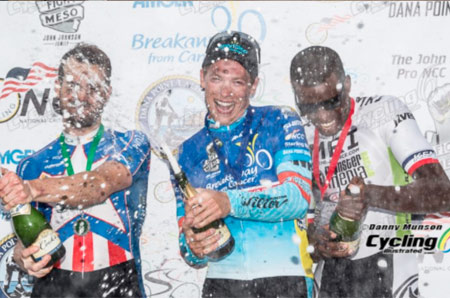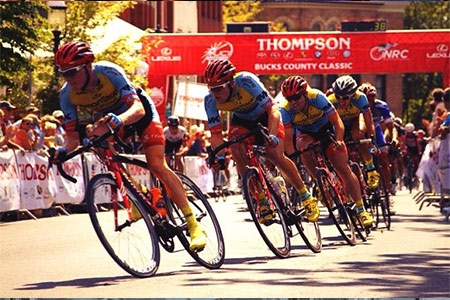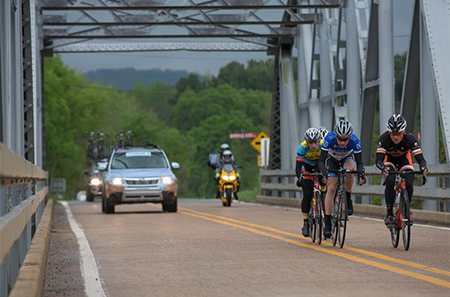There are more than 57 million cyclists nationwide – from recreational, to fitness-oriented, to competitors and commuters. Nearly 95,000 are registered bike racers who compete in ability and age-graded categories. Every weekend of the year, there are mountain bike, road bike, and cyclo-cross events for amateurs, weekend warriors, and pros. During the week, group rides and training races keep us enthusiasts pedaling.
Despite the incredible amount of dedicated people who actively participate in cycling, either for hobby or for competition, the sport is relatively misunderstood by the general population where football, baseball, and basketball dominate the national athletic attention.
Cycling is an inviting sport, open to all ages and all fitness levels….and it’s not that different from the “mainstream” sports Americans are accustomed to. Just like these sports, cycling has many teams, players with specific roles, crazy fans, tailgating , sponsors, packed venues, and a big trophy. We even have our “Backyard Bowl” equivalents. The “Wednesday Night World Championships” may not be a sanctioned event but you can bet everyone who shows up will be gunning for the coveted town sprints and mountain top elevation signs.
The Teams
To someone unfamiliar with cycling, the sport may appear to be a group of goofy guys in spandex all going as hard as they can and the fastest man wins. This is far from the truth however. More often than not, the smartest guy with the best team wins the race. Each rider has a specific role, just as wide receivers, free safeties, and linemen have individual jobs to do.
Professional road races in the US allow teams to field eight riders. With 10 to 20 teams per event, there are many strategies and various goals, but ultimately each team wants to win the race. Let’s pretend that a race is 100 miles long with rolling terrain, a long climb in the middle, and flat run into the finish. This type of race is hard to predict as there are many variables. To address this, a team director – similar to a head coach of a football team – may select a roster that can employ multiple strategies. The team has to be diverse enough to win in various ways but also cohesive enough to work as a unit.

The Running Back
One rider will be the dedicated sprinter; fast twitch, ballsy and willing to barge his way through other riders in a hectic 35+ mph finish. The sprinter is typically muscular and reserved from action until the closing kilometers. His job is solely to close the deal if the race comes to the finish line as a big group still intact. In football terms, he’s a third down back, reliable, and able to get across the goal line for the score. Throughout the season this position is utilized more than any but there is also a lot of added pressure when you are expected to deliver every single time.

The Full Back
Of course the sprinter doesn’t always do it alone. Not only does he have to survive the first 99 miles that may not be to his advantage, but he has to also find the right lines to sneak through, while 10-20 other teams and sprinters are doing the same. That’s where the lead out man comes in. A very competent sprinter in his own right, the lead out man helps launch the sprinter into the finishing 200 meters. The duo is the most successful when there is complete trust between the two. The sprinter trusts the lead out man to find the fastest and safest lines. Likewise, the lead out man trusts that the sprinter will take advantage of his sacrifice. Much like the full back position, the lead out man is sometimes overlooked, but also gets “carries” when the terrain suits him better.
The Linemen
When was the last time you heard of an NFL offensive lineman running a route and catching a 50 yard deep ball? Never. That’s not their job. How many linemen are household names? The same is true in cycling. Many teams employ well rounded strong men who aren’t necessarily the quickest in a bunch gallop nor the fastest up the steep grades. But these guys can do it all and take pride in taking a serious pounding for their teammates. When teams begin forming their “trains” to set up the lead outs and protect their sprinter, 3-5 of the 8 riders line up at the head of the race with the sprinter and lead out man in tow.

With all of the teams setting up, there is a battle to keep and hold the front. The front is safer, less prone to crashes and much easier to find and create space for the sprinter in the finale. These “linemen” go head to head with other teams and eventually wear down. When their job is done, they may cross the line in 83rd two minutes back but hopefully when they roll under the finish banner they find their sprinter celebrating on the podium.
The Hail Mary
No two races are exactly alike. Varying terrain, weather, unfortunate mishaps and of course the rival teams’ strategies dictate how a race plays out. And likewise, there are just as many ways to win; The long breakaway, the last kilometer attack, and the come from behind victory.

If teams lose their fast finishers due to mechanicals or crashes or simply want another option, riders attempt to get into a breakaway or go solo to the line. Outrunning an entire peleton from early on in the race has slim odds but sometimes it’s the best card to play. Other times throwing the deep ball like this is strategic. It causes other teams to rethink their strategies, mark, or even use “double coverage” the same way a free safety and corner back tag team a dangerous wide receiver. More often than not these “Hail Mary” plays don’t work out, and sometimes they simply help their sprinter and other teammates from having to work, but when it succeeds it’s memorable and can define a rider’s season or even a career.
Check back soon for Cycling For The Football Fan, Part II
Coaching Tip:
This time of year is a good time to start planning for the next road season. With unstructured riding at the end of the road season until now, buckling down and focussing can be hard to do. Getting back in the swing of things by creating a regular habit is a good place to start. There’s no need to go out and smash every ride. Right now, endurance pace, consistency and increasing volume are keys. With the weather changing its also very important to protect your joints. I typically recommend covering your knees when the mercury dips below 70.
About Curtis Winsor
Living in Crozet, VA, at the base of Afton Mountain, Curtis Winsor is a second year professional cyclist riding for Team Smart Stop. Though he has been racing and training for over 10 years, it wasn’t until Curtis moved to the Shenandoah Valley that he actually learned to love riding. When his best friend introduced him to the beautiful mountain views and hidden fire roads the Blue Ridge had to offer, it was easier to turn a two-hour training ride into a six hour adventure.
While working his way up to the professional level, Curtis also graduated from JMU, helped produce and promote an award winning cycling documentary, Chasing Legends, began Winsor Creative – a full service design and identity solution for small businesses and began coaching junior and senior cyclists. Curtis also has a passion for junior development hopes to help grow the Virginia High School MTB League.
When not riding, Curtis and his wife Alexa love to cook, hike, play board games (I will crush you in Settlers of Catan) and find eclectic restaurants.






